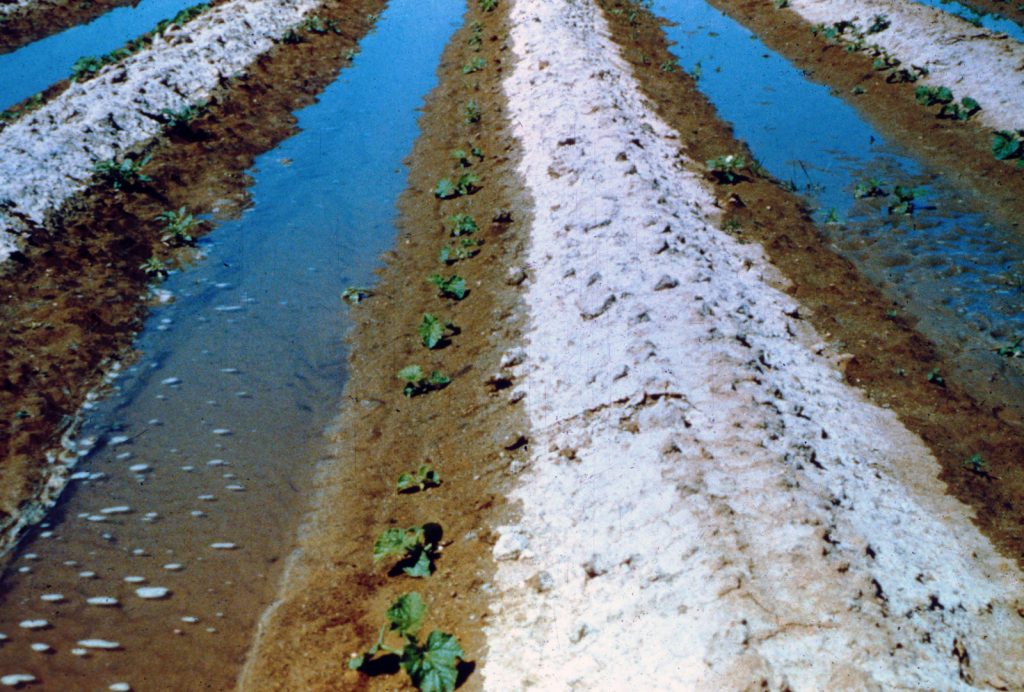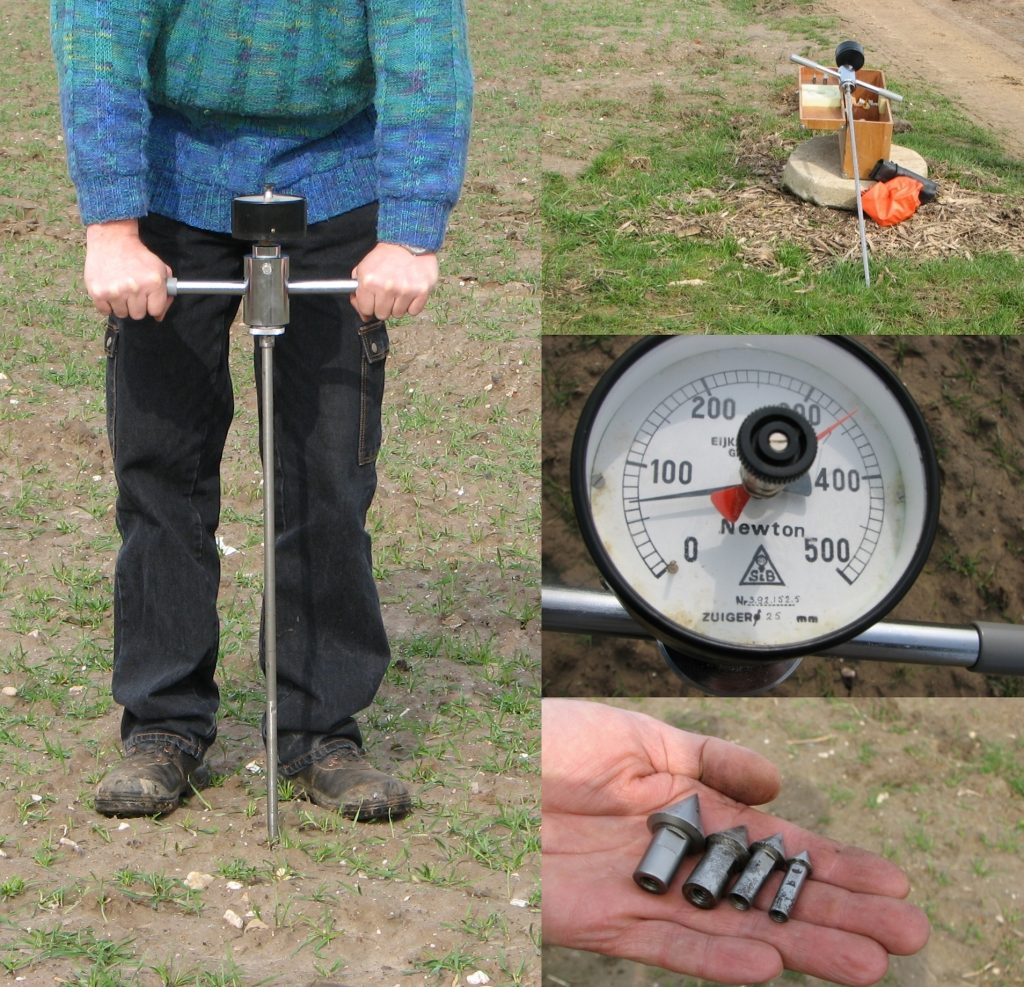8 Rehabilitation of Problem Soils
Colby Moorberg and Brooke Hogan
Abbreviations
NRCS – Natural Resources Conservation Service
PDF – Portable Document Format
URL – Uniform Resource Locator
US – United States
USDA – US Department of Agriculture
Acid Soils
Crozier, C. R., and D Hardy. 2017. “Soil Acidity and Liming for Agricultural Soils.” Extension Bulletin AG-439-50. SoilFacts. Raleigh, NC: North Carolina State University. https://content.ces.ncsu.edu/soil-acidity-and-liming-for-agricultural-soils.
This bulletin, published by the North Carolina State Extension Service, educates local producers about the benefits of using lime to reduce soil acidity. Crozier describes the naturally acidic conditions of soil in North Carolina and causes of soil acidity. This acidity can be corrected by liming soils. Crozier thus describes the benefits of liming soil and soil testing to determine liming rates, providing an example of how to calculate liming rates. Crozier also describes liming materials, making adjustments to application rates based on lime type, purity, and fineness, and other considerations for applying lime and using no-till.
Saline, Sodic, and Saline-sodic Soils

Horneck, D.A., J.W. Ellsworth, D.M. Sullivan, B. Hopkins, and R. Stevens. 2007. “Managing Salt-Affected Soils for Crop Production.” PNW 601-E. A Pacific Northwest Extension Publication. Bend, Oregon, US: Oregon State University, Washington State University, University of Idaho. https://pubs.wsu.edu/ItemDetail.aspx?ProductID=15000&SeriesCode=&CategoryID=141&Keyword=.
This Pacific Northwest Extension bulletin focuses on salts and salt-affected soils in the western US although the principles and concepts do apply in other regions. The authors begin by describing salts and the types of salt-affected soils: saline, sodic, and saline-sodic soils. They then summarize the various soil tests that can assess salinity and sodicity. Next, the authors explain how salt tolerance varies across crop species and how ion toxicity changes salt-affected soils. The bulletin ends with strategies for managing and reclaiming salt-affected soils, as well as a section on soil testing questions and answers.
McCauley, Ann, and Clain Jones. 2005. “Module 2 – Salinity and Sodicity Management 4481-2.” In Soil and Water Management, 16. Bozeman, MT: Montana State University. http://landresources.montana.edu/swm/.
The Montana State University Extension Service published this online module for extension agents, crop advisers, and local producers, providing an overview of the formation, symptoms, and management of salt-affected soils. The risk of salinization, or the accumulation of water-soluble compounds, increases with poor soil drainage, arid climate, poor quality irrigation water, and salt-containing soil amendments. There are three classes of salt-affected soils: saline, sodic, and saline-sodic. Each is characterized by different electrical conductivity, total dissolved solids, pH, and exchangeable sodium percentage. Plants in salt-affected soils undergo stress due to osmotic potential differences, damaged soil structure, and salt toxicity. Reclamation of salt-affected soils includes methods that flush land with irrigation water, add calcium- and magnesium-containing soil amendments, and plant salt-tolerant plants.
Ruiz Diaz, D., and D. Pressley. 2017. “Management of Saline and Sodic Soils.” MF-1022. Manhattan, KS: Kansas State University Agricultural Experiment Station and Cooperative Extension Service. https://www.bookstore.ksre.k-state.edu/Item.aspx?catId=364&pubId=525.
In this Kansas State University Research and Extension publication, Ruiz Diaz and Presley review identification and reclamation of salt-affected soils. Soils characterized as saline, sodic, or saline-sodic are first described, followed by descriptions of soil tests for diagnosis, such as electrical conductivity and exchangeable sodium using an ammonium acetate extraction. Managing salt-affected soils is then discussed. Adjusting plant populations to salt- and sodium-tolerant crops is the most effective management practice for slightly- to moderately-affected soils. Soils more severely affected by salts and/or sodium must be treated using other strategies. Recommendations include chemical soil amendments, crop residue, and irrigation.
Compacted Soils
DeJong-Hughes, Jodi. 2014a. Soil Compaction (1st in Series). Soil Compaction. St. Paul, MN: University of Minnesota Extension Crops. https://www.youtube.com/watch?v=2TNqIrLe6J4.
In this extension video from the University of Minnesota, DeJong-Hughes reviews soil compaction and its negative effects on soil and crop health. DeJong-Hughes describes methods for limiting compaction: avoiding operating farm machinery under moist soil conditions, reducing axle load, properly inflating tires, properly sizing tires, and controlling wheel traffic. She also addresses a common myth that freeze-thaw cycles alleviate compaction from farm machinery and states that the weight of modern farm machinery causes compaction deep in the soil where freeze-thaw cycles do not occur frequently enough to break up compaction.
DeJong-Hughes, Jodi. 2014b. Soil Compaction: Proper Tire Inflation (4th in Series). Soil Compaction. St. Paul, MN: University of Minnesota Extension Crops. https://www.youtube.com/watch?v=dUbmeNYpcRI.
This University of Minnesota extension video demonstrates how proper tire inflation limits compaction and improves traction. Properly inflated tires have larger area of tire in contact with the soil, which distributes the axle load and limits the depth of compaction in the soil. Using the largest tire with the lowest tire inflation pressure will reduce potential compaction. The axle load can also be distributed over a larger area by using duals or triples, which increases the load capacity. New technologies that help operators manage tire pressures are also discussed.
DeJong-Hughes, Jodi. 2014c. Soil Compaction: Tracks and Tires (3rd in Series). Soil Compaction. St. Paul, MN: University of Minnesota Extension Crops. https://www.youtube.com/watch?v=fNsRFUWOqbo.
DeJong-Hughes describes the differences between tires and tracks in compaction in this extension video from the University of Minnesota. She explains that ground pressure for tires is very close to tire pressure, and that proper tire inflation depends on axle load, number of tires, and tire size. In contrast, ground pressure from tracks is calculated by dividing the weight on the tracks by the area of track in contact with the soil, though pressure spikes do occur immediately below the bogey wheels. DeJong-Hughs enumerates advantages to both tires and tracks and summarizes the advantages of each system. She then summarizes the practice of controlled wheel traffic, in which wheel or track traffic is restricted to the same paths across the field for as many field operations as possible. The final recommendation is to restrict grain cart traffic to paths already created by the combine or limiting erosion to endrows and keeping the carts off of the rest of the field.
DeJong-Hughes, Jodi. 2014d. Soil Structure: A Natural Defense against Soil Compaction (2nd in Series). Soil Compaction. St. Paul, MN: University of Minnesota Extension Crops. https://www.youtube.com/watch?v=HZDJ59Vf9lc.
In this extension video from the University of Minnesota, DeJong-Hughes explains why soil structure is important and how good structure can help resist compaction. Mycorrhizal fungi improve soil structure by producing glomalin, a glue that holds soil particles together. Strategies for encouraging these fungi and glomalin are reducing soil tillage, using crop rotation, leaving organic matter on the surface, or using cover crops. A slake test shows how to assess aggregate stability.
DeJong-Hughes, Jodi, John F. Moncrief, W. B. Voorhees, and J. B. Swan. 2001. “Soil Compaction: Causes, Effects and Control.” Extension Publication FO-3115-S. St. Paul, MN: University of Minnesota. https://conservancy.umn.edu/handle/11299/55483.
This bulletin from University of Minnesota Extension Service reviews soil compaction. The authors present this information in sections, beginning with soil compaction causes and consequences, surface compaction, subsoil compaction, and control. Useful figures and diagrams are presented throughout the bulletin. The authors identify two types of compaction: surface and subsoil. Both types reduce soil moisture availability and nutrient uptake. Surface compaction can be remedied using tillage, but subsoil compaction is more difficult to resolve although it can be alleviated via subsoiling, split application of fertilizers, and/or reducing equipment traffic. To avoid compaction, wait for fields to dry before running equipment through them.
Duiker, Sjoerd W. 2002. “Diagnosing Soil Compaction Using a Penetrometer (Soil Compaction Tester).” Extension Publication 63. Agronomy Facts. State College, PA: Pennsylvania State University. https://extension.psu.edu/diagnosing-soil-compaction-using-a-penetrometer-soil-compaction-tester.
Duiker explains how a penetrometer can measure the extent of soil compaction in this extension bulletin from Pennsylvania State University. Penetrometers are instruments consisting of a steel shaft with a cone on the tip and a gauge on a handle that measures the amount of force necessary for the cone to penetrate the soil. Duiker states that penetrometer measurements should be taken approximately 24 hours following a rain event at a sampling rate of three to four measurements per acre. When penetration resistance exceeds 2000 kPa (300 psi), the compaction present can limit root growth. The percentage of readings that result in root-limiting conditions within 15 inches of the soil surface should be recorded. Fields with percentages of 30-50 are slightly compacted, 50-75 are moderately compacted, and more than 75% are severely compacted.

USDA NRCS. 2015. Controlled Traffic Farming. Conservation Practice Standard 334. 3. Washington, D.C.: USDA. https://www.nrcs.usda.gov/wps/PA_NRCSConsumption/download?cid=nrcseprd340739&ext=pdf.
In this conservation practice standard, the USDA NRCS defines controlled traffic farming as the practice of “confining all high load wheel/track traffic from farm equipment to specific lanes or tramlines (traffic pattern) in crop fields year after year.” This practice can improve soil health by limiting compaction due to wheel or track traffic and can be used where traffic can be limited to specific traffic lanes. The conservation practice uses specific criteria and considerations, with plans and specifications based on those criteria and considerations, followed by operations and maintenance. The URL offers a direct download of a PDF of this resource.
USDA NRCS. 2015. Controlled Traffic Farming. Conservation Practice Standard Overview 334. 1. Washington, D.C.: USDA. https://www.nrcs.usda.gov/wps/PA_NRCSConsumption/download?cid=nrcseprd404636&ext=pdf.
This conservation practice standard overview should guide producers and USDA NRCS conservation planners as they implement BMPs. Controlled traffic farming requires confining heavy farm equipment traffic to specific lanes year to year. The goal is to limit heavy vehicle loads to those areas to reduce soil compaction. The benefits of controlled traffic farming include improved soil health, efficient use of nutrients, better yields, and higher soil water availability. The URL offers a direct download of a PDF of this resource.
USDA NRCS Soil Quality Institute. 2003. “Soil Compaction: Detection, Prevention, and Alleviation.” Agronomy Technical Note 17. Soil Quality. Auburn, AL: USDA NRCS. https://www.nrcs.usda.gov/Internet/FSE_DOCUMENTS/nrcs142p2_053258.pdf.
This technical note from the USDA NRCS Soil Quality Institute is an overview of soil compaction. In it, the Soil Quality Institute details the causes, detection, types, treatments, and prevention of soil compaction. Five types of compaction are defined: surface crusting, surface compaction, tillage pans, deep compaction, and inherent hardpans. Compaction can be measured using bulk density, tools like penetrometers, or field indicators like plant productivity and soil structure. To prevent soil compaction, the Soil Quality Institute encourages reducing equipment traffic and allowing fields to dry before working them. To remediate compaction, subsoiling is recommended. The URL offers a direct download of a PDF of this resource.

